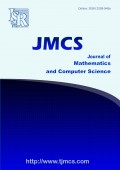Attribute Based Level Adaptive Thresholding Algorithm (ablata) for Image Compression and Transmission
-
2440
Downloads
-
3466
Views
Authors
Ankush Rai
- CRIAD Laboratories, Bhilai.
Abstract
Image processing plays a vital role in the computer vision because most of the scenarios require object extraction and recognition. But there lies a self-concatenated issue with it because such an algorithm is also supposed to simultaneously solves the problem of image restoration and transmission. In order to achieve this objective we furthered the effective ABLATA algorithm for the same Once the image is denoised and features are extracted then it can be resized to the half of the actual image, compressing it in a mathematical equation that shall help it restore with the half of the data and thus can readily be restored with the half of the actual imagery data to reproduce it, while maintaining the high image quality. The advantage of such a process is the low storage cost and image transmission requires less time than that required by the original one.
Share and Cite
ISRP Style
Ankush Rai, Attribute Based Level Adaptive Thresholding Algorithm (ablata) for Image Compression and Transmission, Journal of Mathematics and Computer Science, 12 (2014), no. 3, 211-218
AMA Style
Rai Ankush, Attribute Based Level Adaptive Thresholding Algorithm (ablata) for Image Compression and Transmission. J Math Comput SCI-JM. (2014); 12(3):211-218
Chicago/Turabian Style
Rai, Ankush. "Attribute Based Level Adaptive Thresholding Algorithm (ablata) for Image Compression and Transmission." Journal of Mathematics and Computer Science, 12, no. 3 (2014): 211-218
Keywords
- Computer Vision
- Object Extraction
- Image denoising Image Compression
- Transmission.
MSC
References
-
[1]
Yang Wang, Haomin Zhou, Total Variation Wavelet-Based Medical Image Denoising, International Journal of Biomedical Imaging, 2006 (2006), 1-6.
-
[2]
Ahmed Badawi, Scatterer Density in Nonlinear Diffusion for Speckle Reduction in Ultrasound Imaging: The Isotropic Case, International Journal of Biological and Life Sciences, 2 (2006), 149-167
-
[3]
Fernanda Palhano, Xavier de Fontes, Guillermo Andrade Barroso, Pierre Hellier, Real time ultrasound image denoising, Journal of Real-Time Image Processing, 1 (2010), 15–22
-
[4]
Shujun Fu, Qiuqi Ruan, Wenqia Wang, Yu Li, Feature Preserving Nonlinear Diffusion for Ultrasonic Image Denoising and Edge Enhancement, World Academy of Science, Engineering and Technology, 2 (2005), 148-151
-
[5]
Tanaphol Thaipanich, Jay Kuo, An Adaptive Nonlocal Means Scheme for Medical Image Denoising, In Proceedings of SPIE Medical Imaging, Vol. 7623, San Diego, CA, USA (2010)
-
[6]
Su Cheol Kang, Seung Hong Hong, A Speckle Reduction Filter using Wavelet- Based Methods for Medical Imaging Application, In Proceedings of 23rd Annual International Conference of the IEEE Engineering in Medicine and Biology Society, Istanbul, Turkey, 3 (2001), 2480-2483
-
[7]
Jose V. Manjón, Neil A. Thacker, Juan J. Lull, Gracian Garcia-Marti, Luis Marti-Bonmati, Montserrat Robles, Multicomponent MR Image Denoising, Journal of Biomedical Imaging, 2009 (2009), 1-27
-
[8]
Malik Perona, Scale-space and edge detection using anisotropic diffusion, IEEE Transaction on Pattern Analysis and Machine Intelligence, 12 (1990), 629-639
-
[9]
Robles Manjon, Thacker, Multispectral MRI de-noising using non-local means, In Proceedings of MIUA, Aberystwyth, (2007), 41-46
-
[10]
Kubler Gerig, Jolesz Kikinis , Nonlinear Anisotropic Filtering of MRI Data, IEEE Transaction on Medical Imaging, 11 (1992), 221-232
-
[11]
Seyyed Mohammad Reza Farshchi, Mahdi Yaghoobi, A Novel Fuzzy Expert System Using Image Processing for Sale Car Shape with Online Membership Function, Journal of Mathematics and Computer Science (JMCS), 2 (2011), 222 - 232.
-
[12]
Moslem Taghizadeh, Mohammad Reza Mahzoun , Bidirectional Image Thresholding algorithm using combined Edge Detection and P-Tile algorithms, Journal of Mathematics and Computer Science (JMCS), 2 (2011), 255 - 261.
-
[13]
Khosro Jalali, Mostafa Heydari, Asma Tanavar, Image Segmentation with Improved Distance Measure in SOM and K Means Algorithms, Journal of Mathematics and Computer Science (JMCS) , 8 (2014), 367 - 376.
-
[14]
J. Vahidi, M. Gorji, The Confusion-Diffusion Image Encryption Algorithm with Dynamical Compound Chaos, Journal of Mathematics and Computer Science (JMCS), 9 (2014), 451 - 457.
-
[15]
Ankush Rai, Attribute Based Level Adaptive Thresholding Algorithm for Object Extraction, Journal of Advancement in Robotics, 1 (2014), 29-33

